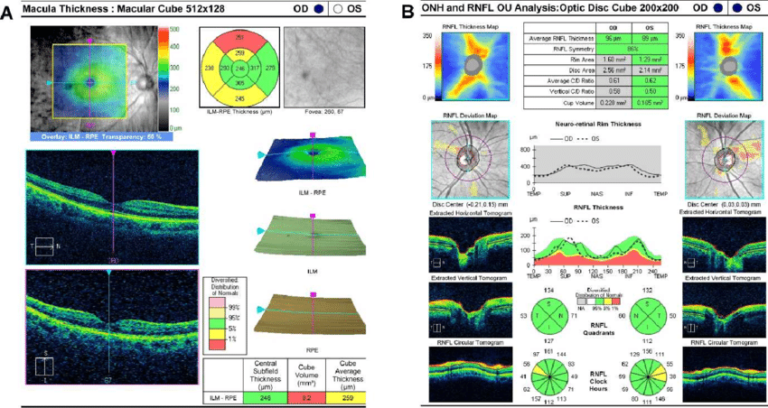8 reasons for optic nerve cupping
“Optic nerve cupping” is a medical term that refers to the enlargement or deepening of the optic nerve head cup. The optic nerve head, also known as the optic disc, is the point where the optic nerve exits the eye and connects to the brain. The central area of the optic disc is called the cup. Optic nerve cupping occurs when this cup becomes larger or deeper than normal. This enlargement is often a result of damage to the optic nerve fibers.
Following are the conditions in which optic nerve cupping occurs
Glaucoma
The increased pressure within the eye in primary or secondary open or closed angle glaucoma can compress blood vessels that supply the optic nerve with nutrients and oxygen. Compression of blood vessels can lead to impaired blood flow to the optic nerve head. The optic nerve head is a critical structure responsible for transmitting visual information from the retina to the brain. The compromised blood flow to the optic nerve head results in ischemia which leads to damage and death of the optic nerve fibers. As the optic nerve fibers degenerate, the structural support within the optic nerve head weakens. This causes the central area of the optic disc, known as the cup, to enlarge or deepen, resulting in optic nerve cupping.
Normal tension glaucoma
Normal-tension glaucoma is a subtype of glaucoma where optic nerve damage and visual field loss occur despite IOP being consistently within the normal range (typically below 21 mmHg). One prominent theory suggests that abnormal regulation of blood flow to the optic nerve head plays a significant role in NTG. Insufficient blood supply, also known as ischemia, can lead to damage to the optic nerve fibers even in the absence of elevated IOP. Factors such as blood vessel abnormalities, systemic vascular conditions, or fluctuations in blood pressure may contribute to vascular deregulation leading to optic nerve head damage and cupping.
Optic disc edema
Optic disc edema can be a consequence of increased intracranial pressure, often due to conditions such as idiopathic intracranial hypertension (IIH) or space-occupying lesions within the skull. Elevated intracranial pressure can lead to mechanical compression of the optic nerve at the level of the optic disc. Compression and impaired axoplasmic flow can lead to compromised blood flow to the optic nerve head leading to damage of the optic nerve fibers. As the nerve fibers degenerate and the structural support within the optic nerve head weakens, optic nerve cupping may occur.
Optic nerve tumors
Optic nerve tumors can cause optic nerve cupping through a combination of mechanical compression, disruption of normal tissue architecture, and increased intraocular pressure. Tumors that affect the optic nerve or its surrounding structures can exert physical pressure on the nerve fibers. This compression can compromise the blood supply to the optic nerve and impede the normal flow of axoplasm within the nerve fibers resulting in the enlargement or deepening of the optic nerve cup, leading to cupping.
Retinal vein occlusion
Retinal vein occlusion (RVO) is a vascular disorder that occurs when a vein in the retina becomes blocked, leading to a variety of complications, including potential damage to the optic nerve head and the possibility of optic nerve cupping. Reduced blood flow and ischemia can cause swelling and edema in the affected area, including the optic nerve head. This swelling is often referred to as optic disc edema along with ON head cupping.
Central retinal artery occlusion
Central retinal artery occlusion results in a sudden and severe reduction of blood flow to the retina. The lack of oxygen and nutrients can lead to ischemia, causing damage to the retinal tissues, including the nerve fibers. The optic nerve head is closely connected to the retina, and both structures are affected by changes in blood flow.
Optic nerve drusen
Optic nerve drusen are calcified deposits that accumulate in the optic nerve head. While optic nerve drusen themselves do not directly cause optic nerve cupping, the presence of drusen can lead to structural changes in the optic nerve head leading to alterations in the shape and integrity of the optic disc.
Retinitis pigmentosa
ON head cupping in retinitis pigmentosa (RP) is a result of the progressive degeneration of the retina and the associated changes in the optic nerve head. Retinitis pigmentosa is a group of inherited disorders that primarily affect the light-sensitive cells (rods and cones) in the retina, leading to gradual vision loss. The optic nerve head may undergo remodeling and changes in shape due to the reduced support from the retinal nerve fibers. As the optic nerve head undergoes structural changes, the cup may enlarge or deepen.
The progression of retinitis pigmentosa and optic nerve head cupping is often associated with visual field constriction, particularly in the peripheral vision. This constriction can contribute to tunnel vision.
Founder of EyesMatterMost- an optometry student who loves talking about eyes. I tend to cover topics related to optometry, ophthalmology, eye health, eyecare, eye cosmetics and everything in between. This website is a medium to educate my readers everything related to eyes.

